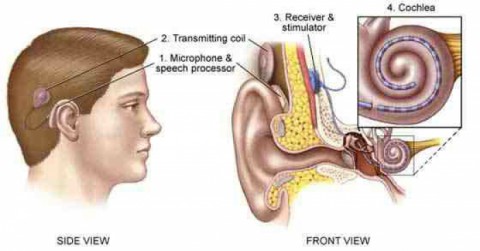Cochlear Implant

Cochlear Implant Department
The Hearing Device Center is committed to providing clinical services to those children and adults with specific needs regarding cochlear implantation and amplification.
Individuals are seen for extensive comprehensive evaluations to determine both audiological and surgical candidacy and receive extensive information regarding device options.
Our facility offers a selection for implantation of all FDA approved manufacturer’s devices including Cochlear Corporation, Advanced Bionics and Med-El.
How Does Hearing Work?
In order for the normal process of hearing to take place, all of the intricate components of the outer, middle and inner ear must function normally. If one of the components is damaged, malformed or missing- a hearing loss may be present.
The ear is made up of three parts:
- Outer Ear: The visible part of the ear, the pinna or auricle, collects sound from the environment and funnels it into the middle ear.
- Middle Ear: Comprised of the eardrum (tympanic membrane) connected to three tiny bones that move together to send sound vibrations to the inner ear.
- Inner Ear: Comprised of two main parts: the cochlea, which contains the intricate hair cells (sensory cells); and the vestibular system, which controls your balance. The hair cells are responsible for sending impulses to the auditory nerve fibers, then on to the brain for interpretation into sounds.
Cochlear Implant Evaluation Process
All patients will be seen for a candidacy evaluation by the cochlear implant audiologist and the implant surgeon. Pediatric candidates will also be evaluated by the speech-language pathologist. General hearing and health history, hearing device use, and educational placement/therapy services will be some of the topics reviewed during the evaluation appointments. A separate appointment will be made for a CT Scan to assess your inner ear. Audiologic unaided and aided testing will be performed to assess hearing ability and benefit as well as an assessment of word recognition ability with amplification devices. Additional evaluations may be recommended. These may include, but are not limited to: Psychological Evaluation, Physical Therapy/Occupational Therapy Evaluation, and Vision Assessment.
Once a patient is determined to be a cochlear implant candidate, the following will be reviewed:
- How the Implant works
- Expectations for device use
- Choice of implant devices for use and how they function
- Surgery process/Date/Ear for implantation selection
- Cochlear implant programming follow-up
- Educational placement
- Rehabilitative service
- Other evaluations needed to complete candidacy work-up
- All short and long term costs involved in the surgical, audiological, and rehabilitation processes, as well as maintenance of implant equipment
What is involved with implant surgery?
Cochlear Implant surgery is performed under general anesthesia. The patient is placed on their back with their head turned away from the side of surgery. A small amount of hair is shaved, and an outline is traced around the receiver/stimulator area on the side of the head where the implant will be placed. The placement of the receiver/stimulator won't interfere with the Behind the Ear.
Cochlear Implant Surgery
Indications for Surgery
Severe to Profound Sensorineural Hearing Loss is an indication that you may need surgery.
Anesthesia
This procedure requires a General Anesthetic.
Surgical Time
The length of this procedure is 1 hour for unilateral implantation, or 1 3/4 hours for bilateral implantation.
Hospital Admission
Patients less than 1 years of age require an overnight admission to the hospital. Patients between 1 and 65 years of age may have their procedure on an outpatient basis.
CI Programming & Follow-up
Patients return for initial programming of their device approximately three to four weeks following surgery. The audiologist that is working with you in the clinic will fit the external equipment to make sure that all components are appropriate. The speech processor is then connected to a computer for programming. The audiologist, with the help of the cochlear implant recipient, sets the “softest” sound and a “comfortably loud” sound for specific contacts point for the internal cochlear implant. Expectation levels for how the device will sound are discussed prior to programming. Once programming has been completed and a useable program has been downloaded to the processor, the external equipment function is reviewed with the recipient. You can expect approximately 7 follow up visits in the first year to allow for proper adaptation to the new sound stimulus. After the first year, ongoing, follow-up visits will be scheduled every 6-12 months in order to help fine-tune the program settings, assist the recipient with specific needs, and measure productivity and maximization of device function and use.
The audiologist will help in determining whether the implant recipient is an appropriate candidate for aural (re)habilitation/speech and language therapy. We have a team of therapist they can provide these services. New implant users (children and adults) often find that one-on-one therapy initiated shortly after they obtain their device is very beneficial! The therapist can assist in establishing realistic goals and expectations, help the individual to maximize their listening potential, assist with Individualized Education Program (IEP) goal selection, and provide home program exercises. Even families of children who are already receiving therapy services at school find that adjunct services in the private sector are quite beneficial. Especially because these services are provided here, at the Cochlear Implant Center, allowing for excellent communication and continuity of care between all of the implant team members.

